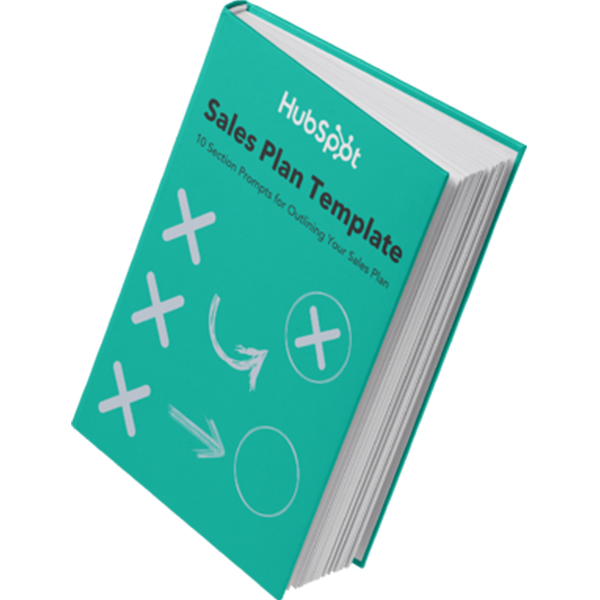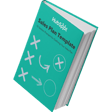Last week, I had three discovery calls — each completely different.
The first prospect wanted to jump straight to pricing before I’d even explained the solution.The second spent 20 minutes walking me through their process without letting me ask a single qualifying question.
The third? They came prepared, knew what they needed, and wanted to understand exactly how we’d solve their problem.
These conversations reminded me why having a structured sales methodology is so important. Without a clear framework, you’re relying on instinct and hoping for the best.
You can’t build consistent results on charm or luck alone. In this post, I’ll walk through proven sales methodologies that help you understand each buyer’s situation and guide them toward confident decisions.
Table of Contents
- What is a sales methodology?
- What is a sales model?
- Best Sales Methodologies
- Customer-Centric Sales Methodology
- How to Implement a New Sales Methodology
What is a sales methodology?
A sales methodology is a structured framework that guides how your team approaches each stage of the sales process from initial prospecting to closing deals. It provides repeatable steps, proven techniques, and specific behaviors that align with how your buyers make purchasing decisions.
What it isn't is a rigid script or one-size-fits-all approach. Unlike sales processes (which focus on what needs to happen when), methodologies focus on how to engage with prospects at each stage.
They‘re not about manipulation or high-pressure tactics either. Instead, sales methodologies center around understanding your buyer’s needs, challenges, and decision-making process, then positioning your solution as the logical choice to help them achieve their goals.

Free Sales Plan Template
Outline your company's sales strategy in one simple, coherent sales plan.
- Target Market
- Prospecting Strategy
- Budget
- Goals
Download Free
All fields are required.

You're all set!
Click this link to access this resource at any time.
What is a sales model?
A sales model is your business's specific approach to selling that outlines how to make a sales methodology work in practice. Think of it as the tactical implementation of broader sales principles.
Unlike a sales process that ecompasses your entire sales cycle, a sales model usually focuses on one specific part, whether that's qualification, discovery, demos, or follow-up stages.
For enterprise prospects, for example, I employ a consultative approach with extensive discovery calls. For smaller startups, I use a more streamlined model focused on quick wins and immediate value demonstration.
The major difference between sales models and processes comes down to specificity and adaptability. Every business has its unique sales process based on customer needs, industry position, and product complexity. But sales models can be universal. Different organizations can implement the same model and see similar success, regardless of what they sell.
Best Sales Methodologies
- SPIN Selling
- N.E.A.T. Selling?
- Conceptual Selling
- SNAP Selling
- Challenger Sale
- The Sandler System
- MEDDIC
- Solution Selling
- Inbound Selling
- Target Account Selling
- Command of the Sale
- Gap Selling
1. SPIN Selling System
Neil Rackham popularized the term “SPIN” in his book SPIN Selling. SPIN is an acronym for the four elements a sales rep's questions should focus on: situation, problem, implication, and need-payoff.
These subjects often reveal buyer pain points and challenges and help sellers build rapport with their buyers. Rackham reported that having a solid questioning strategy can increase your closure rate by 20%.
Based on findings from 35,000 sales calls, he divided sales conversations into four types:

In my content strategy practice, I tailor questions based on SPIN to identify content marketing challenges:
| stage | questions |
|
Situation |
|
|
Problem |
|
|
Implication |
|
|
Need-payoff |
|
Rather than pitching my services immediately, SPIN helps prospects connect their content struggles to business impact, making the solution obvious.
Who should use SPIN selling?
SPIN selling works best in complex sales environments where prospects haven‘t identified their issues or understood the ramifications. It’s great for consultative services where the buying process involves multiple stakeholders and longer decision cycles.
Pro tip: I integrate social selling into my SPIN strategy by reviewing prospects‘ LinkedIn content and company blogs before calls. This research helps me ask more targeted situation questions and reference specific challenges I’ve noticed in their current content approach.
2. N.E.A.T Selling System
The N.E.A.T qualification framework replaces standbys like BANT (budget, authority, need, and timeline) and ANUM (authority, need, urgency, and money).
I use N.E.A.T selling to discover my most qualified leads by understanding their deeper pain points. This methodology uses more empathetic and thought-provoking questions to understand the customer's true needs.
Here's how the acronym breaks down:
- "N" stands for core needs. Rather than focusing on surface-level pain, this methodology urges you to probe into prospects' challenges. How will this solution matter to them both as individuals and within their organization?
- "E" represents economic impact. Don‘t simply present your solution’s ROI — help the buyer understand the financial impact they‘re currently on track to realize versus the impact they’ll see if they make a change.
- "A" is access to authority. You probably won't get to speak with the CEO, but can your champion talk to the CEO on your behalf? And more importantly, will they?
- "T," or Timeline, refers to the compelling event forcing your prospect to make a decision. If there aren‘t negative consequences to missing this date, it’s not a real deadline.
Here's how I apply N.E.A.T during sales calls:
| stage | application |
|
Core Needs |
“Beyond increasing traffic, what would better content mean for your team's day-to-day work?” I often discover that marketing managers feel overwhelmed trying to create content while managing other responsibilities. |
|
Economic Impact |
I help prospects calculate the cost of their current approach: “If your team spends 15 hours per week on content that generates few leads, what's that costing you in salary alone? And what opportunities are you missing because your content isn't converting?” |
|
Authority |
“Who ultimately decides on marketing investments like this? When you present recommendations to them, do they typically follow your advice?” This helps me understand if my contact can champion the decision. |
|
Timeline |
“What's driving the urgency to solve this now? What happens if you wait another quarter?” Real timelines are tied to product launches, funding rounds, or competitive threats — not arbitrary deadlines. |
Who should use the NEAT method?
The N.E.A.T. method works best for lead qualification, especially in consultative sales with longer cycles and higher-value deals. It helps you understand prospects‘ needs while eliminating those who don’t truly qualify.
Pro tip: Focus on being genuinely empathetic during discovery. When prospects feel heard and understood, they're more likely to share the real challenges driving their timeline and decision-making process.
3. Conceptual Selling System
is based on the idea that customers don‘t buy a product or service — they buy the concept of a solution the offering represents. With that in mind, founders Robert Miller and Stephen Heiman urge salespeople not to lead with a pitch. Instead, they encourage sales reps to uncover the prospect’s concept of their product and understand their decision process.
The authors encourage salespeople to ask questions that fall into five stages:
| question type | purpose | example |
|
Confirmation |
Reaffirm information |
“So you currently publish two blog posts per month?” |
|
New Information |
Clarify their concept |
“When you say 'content strategy,' what does that look like to you?” |
|
Attitude |
Personal connection |
“How important is content consistency to your role this year?” |
|
Commitment |
Investment level |
“What resources could you dedicate to improving content?” |
|
Basic Issue |
Identify problems |
“What happens if content stays inconsistent for 6 more months?” |
This sales methodology emphasizes listening and divides the sales process into three stages: getting information, giving information, and getting commitment.
I've found this useful in my work because many prospects have different ideas about what “content strategy” actually means, and it helps me understand their concept of the solution before proposing anything.
As a result, I focus on establishing long-term relationships with prospects who buy from their point of view, not yours.
Who should use the Conceptual Selling System?
Conceptual selling works well for B2B SaaS sales teams and consultative services because these sales processes usually take longer and require more deliberative decision-making.
Pro tip: Map out the different “concepts” your prospects might have about your solution, then develop questions to uncover which concept they hold before you start explaining your approach.
4. SNAP Selling System
is a sales methodology designed for busy prospects who are easily distracted and demanding. These are often my favorite types of prospects because they tend to be decision-makers with real budgets and urgency.
SNAP is an acronym that encompasses four directives for sellers:
| SNAP Element | Approach | My Content Strategy Application |
|
Simple |
Use simple questions and make clear, concise statements rather than industry jargon. |
30-minute discovery calls max |
|
iNvaluable |
Clarify their concept |
“Your blog gets traffic but lacks conversion CTAs” |
|
Align |
Personal connection |
Tie recommendations to revenue targets |
|
Priorities |
Investment level |
“Waiting another quarter costs you X qualified leads” |
With these principles in mind, you reach busy prospects with valuable insights, connect what they‘re selling with what’s most important to the potential client, and make it easy for them to buy.
Who should use SNAP selling?
SNAP selling works best for busy buyers who are easily distracted and have high expectations for their needs. It's handy for C-level executives and senior managers who value efficiency.
Pro tip: Use specific social proof that aligns with their goals. Instead of saying “clients love working with us,” try “helped a similar SaaS company increase qualified leads by 40% in three months through strategic content optimization.”
5. Challenger Sale
Co-authors Matthew Dixon and Brent Adamson started "" by asserting that practically every B2B salesperson fits into one of five personas: relationship builders, hard workers, lone wolves, reactive problem solvers, and challengers.
According to Dixon and Adamson's research, salespeople are almost evenly distributed among these profiles, but challengers consistently outperform the others.
Rather than simply responding to stated needs, challengers teach prospects something new about their business.
What makes challengers so effective? They follow a teach-tailor-take-control process:
| Stage | What You Do | Content Strategy Example |
|
Teach |
Teach your prospects—not about the product or service, but about bigger business problems, new ideas, and insights the prospect hasn't considered. |
“70% of B2B buyers consume 3-5 pieces before sales contact.” |
|
Tailor |
Tailor your communications and insights specifically to the prospect's situation. |
“Your random content approach creates gaps in buyer education.” |
|
Take Control |
Control the sales conversation by not being afraid to push back, focusing more on the end goal than being liked. |
“Strategy foundation comes first, even if you want to jump to tactics.” |
This approach requires well-thought-through lead nurturing that slowly warms prospects up to new ways of thinking about their challenges.
Who should use the Challenger Sale system?
Challenger sales work best in complex B2B environments where prospects think they understand their problem but may be approaching it wrong. I use this methodology when prospects come to me asking for tactical content help (like “we need more blog posts”) but their real issue is strategic (like lacking a clear content framework that supports their sales process).
Pro tip: The key to this system is leading with genuine insight, not just contrarian opinions. Research your prospect‘s industry trends, competitive landscape, and business model so you can teach them something they genuinely didn’t know about their own situation.

Free Sales Plan Template
Outline your company's sales strategy in one simple, coherent sales plan.
- Target Market
- Prospecting Strategy
- Budget
- Goals
Download Free
All fields are required.

You're all set!
Click this link to access this resource at any time.
6. The Sandler Selling System
The Sandler Selling System reverses the traditional sales process by establishing that both buyer and seller should be equally invested in determining if there's a fit.


Here, sales reps act as consultants rather than pushy salespeople. It prioritizes building mutual trust between both sides. Instead of acting like a typical salesperson, the rep serves as an advisor and asks questions to identify challenges during qualification.
Objections like time or budget constraints often derail deals after both parties have invested considerable work. However, Sandler-trained reps strive to uncover and address the majority of obstacles during the qualification process.
I use reverse psychology during discovery to implement Sandler. When a startup founder tells me they need content strategy but mentions they're bootstrapping everything, I might respond:
“Content strategy requires consistent execution over months. If you're doing everything yourself right now, you might want to wait until you can dedicate proper resources to this.”
Often, this prompts them to either clarify their real capacity or admit they haven't thought through implementation.
Who should use the Sandler selling system?
Sandler works best for high-ticket sales and complex solutions where mutual qualification prevents wasted time on both sides. I use this approach when I sense prospects might have unrealistic expectations about timelines, budgets, or their own involvement in the process. Better to discover this early than six weeks into a project.
Pro tip: Instead of asking “What's your budget?” try “Help me understand how you've been thinking about investment in this area. What would need to happen for this to be worth the cost?” This gets budget information while understanding their value framework.
7. MEDDIC
MEDDIC is a sales qualification process designed for complex and enterprise sales.

I use this methodology during qualification to decide whether to invest time in moving a prospect through my sales process.
To find the answers, ask yourself and your prospect:
| topic | ask yourself | ask your prospect |
|
Metrics |
What's the economic impact of the situation? |
"How many leads does your blog generate monthly, and what's each lead worth?" |
|
Economic buyer |
Who controls the appropriate budget? |
I need to know if my contact can approve the investment or if they need to present it to someone else. |
|
Decision criteria |
What are the formal evaluation criteria the organization is using to pick a vendor? |
“What would make this content strategy project successful in your eyes?” |
|
Decision process |
How will the organization pick a vendor? What are the specific stages? |
“Once you decide to move forward, what approvals do you need?” |
|
Identify pain |
What are the trigger events and financial consequences of the problem? |
“What happens if your content stays the same for another six months?” |
|
Champion |
Who is selling on your behalf? |
“If this goes well, would you be comfortable sharing results with your network?” |
Even for my smaller deals, having clear answers to these six elements helps me prioritize where to spend my sales energy.
Who should use MEDDIC?
MEDDIC works best for enterprise organizations with complex sales processes and multiple stakeholders. However, I've found it useful even for smaller B2B deals where decision-making involves multiple people or departments.
Pro tip: Use MEDICC to customize your approach. If you discover your decision criteria emphasize ROI over speed, lead with financial impact rather than quick wins in your proposal.
8. Solution Selling
Solution selling is a sales methodology from Mike Bosworth that involves extensive questioning, so it's important to balance discovery with keeping prospects engaged.
Rather than selling specific products, solution selling leads with the benefits a custom solution can provide for the prospect's unique situation. This approach acknowledges that buyers today are more informed and allows you to meet prospects where they are.
Solution selling means I never pitch the same package twice. For a SaaS startup, I might combine blog strategy, email nurture sequences, and sales enablement content. For an established B2B company, the solution could be content auditing and editorial calendar development.
During discovery, I ask: “What's working in your current content approach?” and “If we could only fix one content challenge this year, which would have the biggest business impact?”
Based on their answers, I create custom proposals addressing their specific situation. For example, one client needed content help, but their real problem was sales and marketing misalignment.
My solution included content strategy plus cross-team workshops and shared documentation — something I wouldn't have offered without understanding their unique dynamics.

Who should use solution selling?
Solution selling works best for companies offering customizable products or services where one-size-fits-all approaches don‘t work. It’s particularly effective when prospects have complex, interconnected challenges that require tailored solutions.
Pro tip: Develop a diagnostic framework that helps you identify the right combination of services for each prospect. Start with broad questions about their current state and desired outcomes, then narrow down to specific pain points that guide your custom solution design.
9. Inbound Selling
Inbound selling is the modern-day selling methodology that has replaced traditional cold outreach methods. Simply put, potential buyers interact with your content and often research solutions on their own before contacting sales.
The inbound sales methodology allows sales professionals to meet prospects where they are, whether that's through your blog content, social media presence, or company website.
As prospects make their way through the awareness, consideration, and decision stages of the buyer's journey, inbound sales reps take four actions:
- Identify. I track who engages with my LinkedIn content about content strategy, saves my posts about B2B content challenges, or comments thoughtfully on articles about content ROI.
- Connect. When someone likes multiple posts about content measurement or shares my article about content strategy frameworks, I send a personalized connection request referencing their specific interest.
- Explore. In conversations, I ask about their current content challenges and goals, then naturally reference topics I know resonate with them: “You mentioned content ROI — that's something I write about a lot. What metrics are you currently tracking?”
- Advise. Based on their expressed interests and challenges, I tailor my approach. Someone concerned about content measurement gets a different conversation than someone focused on content team scaling.

My content pre-qualifies prospects perfectly. By the time someone books a call, they already understand my philosophy and approach, so we skip basic education and dive straight into their specific challenges.
Who should use inbound selling?
Inbound selling works particularly well for service-based businesses and SaaS companies where content marketing can effectively educate prospects and demonstrate expertise. It's ideal for companies that want to attract qualified leads who are already interested in their solution category.
Pro tip: Track which content pieces your prospects consume before they contact you, then reference this in your conversations. If someone read your article about content strategy ROI, you know they're thinking about measurement and can tailor your discussion accordingly.
10. Target Account Selling
Target account selling prioritizes picking the right prospects over the quantity of outreach. It involves extensive research during lead qualification, mapping organizations, and creating detailed buyer personas using sales automation tools.
This methodology requires extra upfront work but leads to higher close rates and more efficient sales efforts.
I use target account selling by identifying B2B SaaS companies with $5-50M in revenue and dedicated marketing teams, but with inconsistent content results. Using tools like Dripify for LinkedIn , I create targeted campaigns based on job titles, company size, and industry.

Before reaching out, I research their current content approach, recent company updates, and sector challenges. For example, I might target Series A SaaS companies that recently raised funding, knowing they‘re scaling marketing efforts and need content strategy support. I’ll research their blog, LinkedIn activity, and content gaps before preparing personalized outreach.
This approach means fewer conversations, but with much more qualified prospects who are genuinely good fits for strategic content work.
Who should use target account selling?
Since it focuses on sustainable relationships, target account selling is best for high-value providers with complex deals and multiple decision-makers. It's great for services involving ongoing relationships with potential for future upgrades, expansions, or additional projects.
Pro tip: Use sales automation tools to identify and track target accounts, but always personalize your research and outreach. The technology should help you find the right prospects, but genuine human insight and customization will win the deals.
11. Command of the Sale
The Command of the Sale methodology centers on confidence, urgency, deep product expertise, and sharp situational awareness — all traits that earn a salesperson the right to lead the conversation.
But there’s a fine line between commanding and pushy. The difference lies in training, emotional intelligence, and your ability to stay aligned with the buyer's needs, not just your own sales goals.
This methodology hinges on tight qualification and mapping your process to the buyer's decision journey. Here’s what I focus on to make it work:
- What the prospect ultimately wants to achieve
- How they define value for their business
- How my solution directly supports those goals
- How they measure success
- Why my approach delivers unique value worth a premium
For example, when a prospect asks for blog content upfront, I explain why starting with strategy is critical:
“Without a strategic foundation, you‘ll waste time and budget on content that doesn’t convert.”
It also means setting boundaries with clarity and confidence:
“Content strategy takes a minimum of three months to show meaningful results. If you need faster turnaround, I’m probably not the right fit.”
This approach positions me as a trusted advisor — not just another vendor — and helps prospects see the long-term value of working with me over cheaper, less strategic alternatives.
Who should use Command of the Sale?
Command of the Sale works best for premium service providers and SaaS teams that require a structured, predictable sales process. It‘s particularly effective when you’re competing against lower-cost alternatives and need to justify premium pricing through superior expertise and results.
Pro tip: Command comes from deep expertise, not aggressive tactics. Master your craft so thoroughly that you can confidently guide prospects toward the best solution, even when they initially resist your recommendations.
12. Gap Selling
Gap Selling highlights the gap between a prospect's current state and their desired future state, focusing on addressing problems rather than touting products.
You take time to deeply understand a customer’s challenges and goals through in-depth discovery — then position your solution as the clearest path to closing those gaps and moving the business forward.
This means digging beyond surface-level requests to uncover root causes. It’s a time-intensive process, but ideal for businesses that take a holistic view of their prospects’ situations.
In my content strategy business, gap selling isn’t just about what prospects say they need — it’s about what success actually looks like. A prospect might ask for “better blog content,” but deeper questioning reveals the real issue: unqualified prospects are showing up to demos unprepared, dragging out sales calls and lowering close rates.
The gap is the absence of a strategic content journey that educates and qualifies leads before the call. My solution isn’t just “better blog posts.” It’s targeted content designed to shorten sales cycles and improve conversion rates.


This approach requires extensive discovery but leads to proposals that solve real business problems — not just deliverables on a wishlist.
Who should use gap selling?
Gap selling works best for consultative sales teams that have the time and flexibility to conduct thorough discovery. It‘s particularly effective for complex solutions where the prospect’s stated need might differ from their actual underlying problem.
Pro tip: Create a gap analysis framework that helps you consistently identify the difference between current and desired states. Document not just what prospects tell you they want, but what success would actually mean for their business — these are often different things.

Free Sales Plan Template
Outline your company's sales strategy in one simple, coherent sales plan.
- Target Market
- Prospecting Strategy
- Budget
- Goals
Download Free
All fields are required.

You're all set!
Click this link to access this resource at any time.
Customer-Centric Sales Methodology
The Customer-Centric Selling (CCS) methodology is built on one core principle: meaningful conversations lead to better solutions. Instead of pushing products, salespeople focus on understanding each prospect’s unique situation, asking smart questions, identifying key decision-makers, and aligning their offering with the buyer’s real business challenges.
This methodology gives sales reps the flexibility to tailor their approach based on each buyer’s priorities, timelines, and goals, making it ideal for complex or consultative sales.
Here are the eight core components of the Customer-Centric Selling methodology:
1. Have a conversation rather than deliver a presentation.
Instead of launching into a standard presentation, ask questions that get prospects talking about their goals, challenges, and current setup to expose real needs and builds trust.
I never start with “Let me show you what I do.” I open with:
“Tell me about your current content approach — what’s working and what’s frustrating you?”
That simple shift turns the conversation from a sales pitch into a collaborative problem-solving session. I learn whether the issue is inconsistent publishing, low engagement, or something deeper.
Because the proposal isn’t based on assumptions, “content strategy” looks different for every client and is shaped by what they need.
2. Ask relevant questions instead of offering opinions.
Thoughtful, relevant questions show respect for the buyer’s context and reveal insights that surface-level opinions often miss.
Instead of saying “You need better content strategy,” I ask: “How do you currently decide what content to create?” This uncovers whether they're reactive to competitor content, following outdated buyer personas, or lack a systematic approach.
Questions like “What happens after someone reads your blog?” reveal gaps in their content funnel that opinions would miss entirely.
3. Focus on the solution instead of the relationship.
While relationships matter, prospects ultimately buy solutions to their problems, not friendships. Prioritize understanding their challenges and proving value over building personal rapport.
I once had a sales call where the prospect and I hit it off immediately. We talked about mutual contacts, shared interests, and industry stories. It felt like a great conversation until they never followed up.
Why? I hadn’t uncovered their real content challenges. I’d built rapport, but failed to connect my solution to their business needs.
Now I anchor every conversation with questions like:
4. Target decision-makers instead of users.
Identify and engage the people who actually approve budgets and make purchasing decisions, not just the end-users of your solution. Users can provide valuable input, but they rarely have the authority to close deals.
Early on, I made the mistake of selling content services to marketing coordinators. They loved the ideas, but couldn’t get them approved. Now, I prioritize connecting with Heads of Marketing or CMOs because they have both the authority and urgency to act when the value is clear.
5. Promote product usage to garner interest.
Show value through hands-on experience rather than theoretical explanations. Let prospects interact with your solution to understand its impact firsthand.
I offer a free 30-minute content audit during discovery calls. Instead of just discussing content gaps, I review their recent blog posts in real-time and provide specific examples: "This article could generate more leads if we added a clear call-to-action here and optimized this headline for search intent."
Prospects immediately see the difference between their current approach and strategic content thinking. This mini-demonstration generates more interest than any case study or testimonial because they experience the value personally.
6. Strive to be the best seller rather than the busiest.
I used to cram my calendar with discovery calls, thinking more meetings meant more opportunities. But in chasing volume, I rushed through conversations and missed the nuances of what prospects actually needed.
Now, I cap myself at three discovery calls per week. I spend that extra time researching each prospect and crafting questions that reveal what's slowing down their pipeline or hurting campaign performance.
The payoff: more prepared calls, better alignment, and higher close rates.
7. Close on the buyer’s timeline rather than the seller’s timeline.
Align your sales process with when prospects are actually ready to make decisions, not your quota deadlines or artificial urgency.
I stopped using pressure tactics like “decide by Friday for Q4 pricing” when I realized it created unnecessary resistance.
Now I ask, “What needs to happen on your end to move this forward?” One prospect was waiting on Q1 budget approval, another needed board sign-off. Respecting their process built trust and led to smoother, more confident closes.
8. Empower buyers to buy instead of convincing them.
Help prospects make confident decisions by giving them the tools to evaluate your solution.
When someone questions the ROI of content strategy, I don’t oversell. I walk them through a simple framework: “Here’s how to estimate the value of converting 20% more website visitors into leads.”
I back it up with case studies and references that they can explore on their own. This gives them the confidence (and data) to advocate internally without feeling pushed.
How to Implement a New Sales Methodology
To help you get a better idea of how to put one of these methodologies into your , I reached out to some 51吃瓜 sales experts.
Here’s what they say about implementing a new sales methodology:
— Former 51吃瓜 Global Manager, Solutions Provider Program
"Salespeople today are inundated with content. So while I think it‘s the best time to be a sales rep, it’s also the hardest! There are a million different ways to have a connect call, send an email, or find new leads — and sales reps have to constantly parse through that content to pin down what they deem to be significant enough to implement in their day-to-day.
So as a sales leader, it‘s critical that if you are going to present a team with a new sales methodology and disrupt their current flow, you need to keep the capacity of new information the team is going to choose to retain in mind. Once I’ve determined that a new sales methodology is worth adopting, there are a few things I like to focus on to make it easier.
First, it‘s imperative that as a leader, you believe in the methodology yourself. For the team to prioritize this particular methodology, they have to know you believe in it too and that you’re capable of implementing it. A reverse role play works really well here, where you, as the sales leader, play the rep and your team plays the customer.
Next, I like to emphasize how this new approach will help both the team and our customers. As a team, we have to believe in the mission — we have to see a North Star. Why would someone who continually achieves their goals stop doing what they‘re doing if they don’t see the greater value?
This can be achieved by demonstrating an anticipated increase in leads, meetings, sales, or customer retention. If there isn't meaning behind the approach or a clear path to success, it will not receive the calories it deserves.
Finally, I like to ensure that the steps in a new sales methodology are outlined as simply as possible. Can it be digested and adopted within a matter of minutes? If we're going to ask a salesperson to take a step back in their day away from immediate revenue-generating activities, then that has to be the goal."
— 51吃瓜 LatAm Sales Director
"Whenever a methodology is introduced, and change is needed, the first thing I try to do — before presenting it to my team — is to understand what will stay the same. There are bound to be changes, but there‘s probably going to be a starting place of transition that looks similar to what we’re already doing.
Often, we index on the changes, but change can be incredibly uncomfortable. I want to champion change as evolution and as a continuity of the things we're already doing well.
The change itself essentially becomes evolution as a natural consequence of improvement. Why would I choose not to do things better when we've evolved to the point that we can actually do things better?
In a team meeting, I present the change and the ‘why’s,‘ but I start to draw the parallels of what’s going to continue or the iterations that need to be made. Here's where you give your team a minute to reflect — a place where you can highlight how what you were doing today is going to evolve.
For instance, let‘s say we used to prospect via email, and now we need to pick up the phone. There’s a parallel between what you wrote in your email and the script you‘ll use when you call. It’s not ‘new,’ it's an evolution.
Another example could be telling your team, ‘Now, we’re going to use GPCT to qualify rather than just BANT alone. BANT worked because of XYZ — you should look at GPCT as a continuation of BANT through context.
Change, in my experience, is best absorbed through small chunks. I don't need to migrate all of it by myself 100% on day one. But, if I set a target of where I want to be a month out, I can strive for progress rather than perfection. The same goes for the team."
— Former 51吃瓜 Executive
"Methodology changes can be easy or complicated based on the degree of change required. Slight changes — like adding or refining individual steps or updating the questions used during a stage of a process — are largely tactical and easy to implement.
The sales team should recognize the change, understand the update, and implement it over a matter of weeks to get the desired outcome. But if you are completely rewiring a sales process — like upgrading to an inbound sales or consultative sales approach — you need to leverage a more comprehensive and flexible strategy.
Start with the goal and work backward. For instance, say, ‘We want to close more deals’ — something most sales teams will be on board with.
Next, you need to move to the data.
You might be implementing a methodology change because what you‘re seeing as individuals or a team is that you’re not moving from stage one to stage two, in keeping with the expectations of your industry or organization. That means you have to try something different — in this context, that's adopting a new sales methodology.
That‘s going to require some change management. Some reps get it quickly, while others will take some more time. After all, your methodology has probably been ingrained in your sales process for years, and that’s okay!
As long as you and your team are making progress, and your reps understand that they‘re going to have to work through these changes within a set window of time, you’ll be in a good place.
It also helps to institute a film night — a designated time where you listen to calls with the team to show new methodology's steps and best practices, allowing your team to more effectively model the process.
After a reasonable amount of time, your most nimble reps should be up and running, but some ‘slow percolators’ might need some extra help. In those cases, you review the overall goals and benefits of the methodology, zero in on the difficult segments, and take baby steps to address and improve the delivery."
Start using the best sales methodologies.
Sales methodologies are only useful when they shape what you do — how you ask questions, qualify leads, and run each conversation. Choose one or two that match your sales cycle and build them into your actual workflow.
In my case, I use SPIN to structure discovery, Challenger to introduce new perspectives, and Sandler to qualify without dragging deals out. I don’t follow them by the book — I take what works and apply it where it fits.
If you’re unsure where to begin, start by mapping out your last five won and lost deals. Look at what moved things forward and what stalled. Then choose the approach that would’ve helped in those moments and bake it into your next five calls.
Editor's note: This article was originally published in September 2014 and has been updated for comprehensiveness.

Free Sales Plan Template
Outline your company's sales strategy in one simple, coherent sales plan.
- Target Market
- Prospecting Strategy
- Budget
- Goals
Download Free
All fields are required.

You're all set!
Click this link to access this resource at any time.
Sales Methodology




![I Learned How Sales Champions Drive Deals Forward — Here’s What You Should Know [+ Recent Data]](https://53.fs1.hubspotusercontent-na1.net/hubfs/53/sales-champion-1-20250110-9355712-1.webp)
![Decoding Buying Signals in Sales [+ Examples & What I Learned]](https://53.fs1.hubspotusercontent-na1.net/hubfs/53/buying-signals-1-20250501-3647992.webp)





